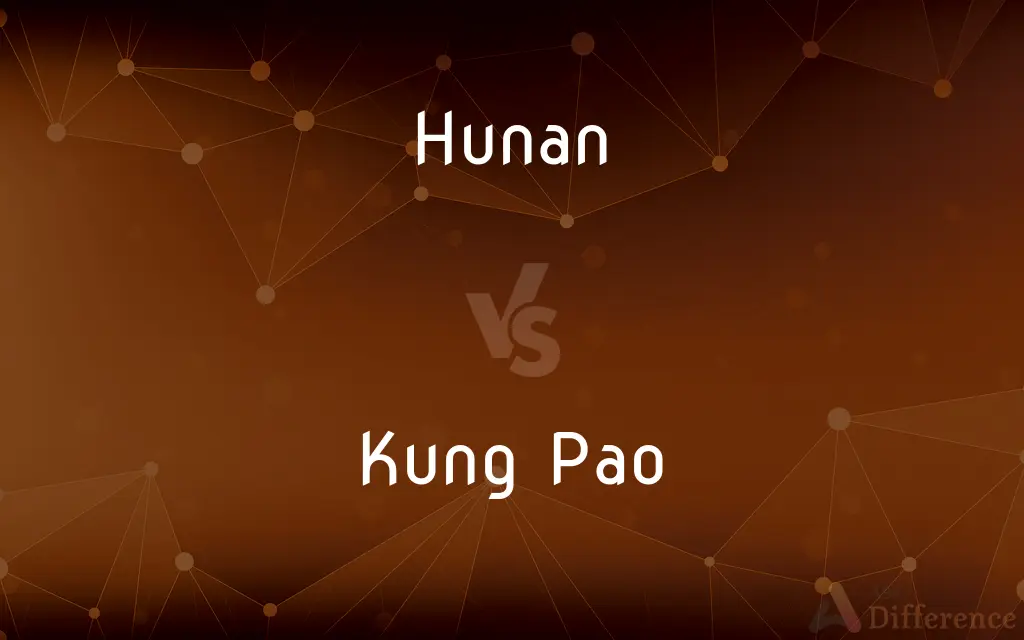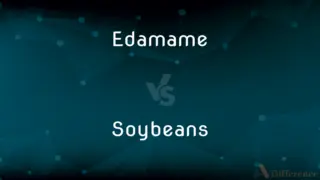Hunan vs. Kung Pao — What's the Difference?
By Tayyaba Rehman — Published on January 31, 2024
Hunan cuisine is known for its hot and spicy flavors with a focus on fresh ingredients; Kung Pao is a spicy, stir-fried Chinese dish made with chicken, peanuts, vegetables, and chili peppers.

Difference Between Hunan and Kung Pao
Table of Contents
ADVERTISEMENT
Key Differences
Hunan cuisine originates from the Hunan Province in China and is renowned for its hot, spicy flavors, and emphasis on fresh, aromatic ingredients. Kung Pao, also known as Kung Pao Chicken, is a popular Sichuan dish known for its spicy and slightly sweet flavors, typically including diced chicken, peanuts, and chili peppers.
In Hunan cuisine, the heat comes primarily from fresh chili peppers and garlic, creating a robust and intense flavor profile. Kung Pao incorporates Sichuan peppercorns, offering a unique numbing sensation alongside its spiciness, which is complemented by the sweetness of hoisin sauce or sugar.
Hunan dishes often showcase a variety of techniques, including smoking, pickling, and braising, and feature a broad array of ingredients like pork, beef, and vegetables. Kung Pao is primarily a stir-fried dish and is relatively consistent in its use of chicken, although variations with other proteins exist.
The flavor of Hunan cuisine is generally characterized as being purer and more straightforward in its spiciness, while Kung Pao offers a more complex interplay of flavors, including sweet, sour, and spicy.
Hunan food is also known for its liberal use of oil and deep, rich colors, often resulting in heartier dishes. In contrast, Kung Pao tends to be lighter, with a focus on the balance of textures, including the crunchiness of peanuts.
ADVERTISEMENT
Comparison Chart
Origin
From Hunan Province, China
From Sichuan Province, China
Spice Source
Fresh chili peppers and garlic
Sichuan peppercorns and chili peppers
Typical Cooking Techniques
Smoking, pickling, braising
Stir-frying
Flavor Profile
Hot and spicy, fresh and aromatic
Spicy, sweet and sour, with a numbing sensation
Common Ingredients
Varied, including pork and vegetables
Chicken, peanuts, vegetables
Compare with Definitions
Hunan
Hunan refers to dishes originating from the Hunan Province in China, emphasizing fresh and fiery ingredients.
The Hunan chicken she cooked was packed with fresh chili peppers and garlic.
Kung Pao
Kung Pao is often made with hoisin sauce or sugar for a slight sweetness.
The slight sweetness in the Kung Pao sauce added a complex layer to the dish.
Hunan
Hunan cuisine often incorporates techniques like smoking and pickling.
The smoked tofu in the Hunan style dish added a unique depth of flavor.
Kung Pao
Kung Pao is known for its crunchy texture from the peanuts.
The crunch of the peanuts in the Kung Pao chicken added a delightful contrast.
Hunan
Hunan dishes are characterized by their liberal use of chili peppers and garlic.
The Hunan shrimp was so spicy that it brought tears to his eyes.
Kung Pao
Kung Pao chicken is a popular Chinese stir-fry known for its balanced sweet, sour, and spicy flavors.
The Kung Pao sauce perfectly complemented the diced chicken and vegetables.
Hunan
Hunan cuisine is a style of Chinese cooking known for its bold, spicy flavors.
He enjoyed the intense heat and rich flavors of the Hunan beef he ordered.
Kung Pao
Kung Pao is a spicy Sichuan dish featuring chicken, peanuts, and chili peppers.
She loved the combination of textures in the Kung Pao chicken.
Hunan
Hunan cooking is known for its hearty and robust flavors.
The Hunan-style stir-fry was both flavorful and satisfying.
Kung Pao
Kung Pao incorporates Sichuan peppercorns for a unique numbing sensation.
The numbing effect of the Sichuan peppercorns in the Kung Pao dish was intriguing.
Hunan
A province in southeastern central China between the Nan Ling mountains and the Chang Jiang; noted for its timber and valuable mineral resources
Common Curiosities
What makes Kung Pao unique?
Kung Pao is unique for its combination of spicy, sweet, and sour flavors with a numbing sensation from Sichuan peppercorns.
What defines Kung Pao?
Kung Pao is a spicy Chinese dish with chicken, peanuts, and a balanced sweet and sour sauce.
Do Hunan dishes use a lot of oil?
Yes, Hunan cooking often uses liberal amounts of oil.
What are common cooking techniques in Hunan cuisine?
Smoking, pickling, and braising are common in Hunan cooking.
Is Kung Pao Chicken a good choice for a balanced meal?
Yes, it offers a good balance of protein, vegetables, and flavors.
What is Hunan cuisine?
Hunan cuisine is a Chinese cooking style known for its bold, spicy flavors.
Are vegetables common in Hunan cuisine?
Yes, vegetables are commonly used in Hunan dishes.
Is Kung Pao suitable for those who don't like very spicy food?
Kung Pao can be adjusted to be less spicy, making it suitable for different tastes.
Is Hunan spicier than Kung Pao?
Hunan can be spicier, focusing on the heat from chili peppers and garlic.
Can I find Kung Pao dishes in most Chinese restaurants?
Yes, Kung Pao is a popular dish and widely available.
What protein is typically used in Kung Pao?
Chicken is the traditional protein in Kung Pao, though other meats can be used.
Which is more popular globally, Hunan or Kung Pao?
Kung Pao is more globally recognized and popular due to its unique flavor profile.
Can Hunan dishes be made vegetarian?
Yes, many Hunan dishes can be adapted to vegetarian preferences.
Does Kung Pao always include peanuts?
Traditionally, yes, but it can be modified for those with allergies.
Are Hunan recipes easy to cook at home?
Yes, with the right ingredients, Hunan dishes can be prepared at home.
Share Your Discovery

Previous Comparison
Edamame vs. Soybeans
Next Comparison
HAWB vs. MAWBAuthor Spotlight
Written by
Tayyaba RehmanTayyaba Rehman is a distinguished writer, currently serving as a primary contributor to askdifference.com. As a researcher in semantics and etymology, Tayyaba's passion for the complexity of languages and their distinctions has found a perfect home on the platform. Tayyaba delves into the intricacies of language, distinguishing between commonly confused words and phrases, thereby providing clarity for readers worldwide.
















































